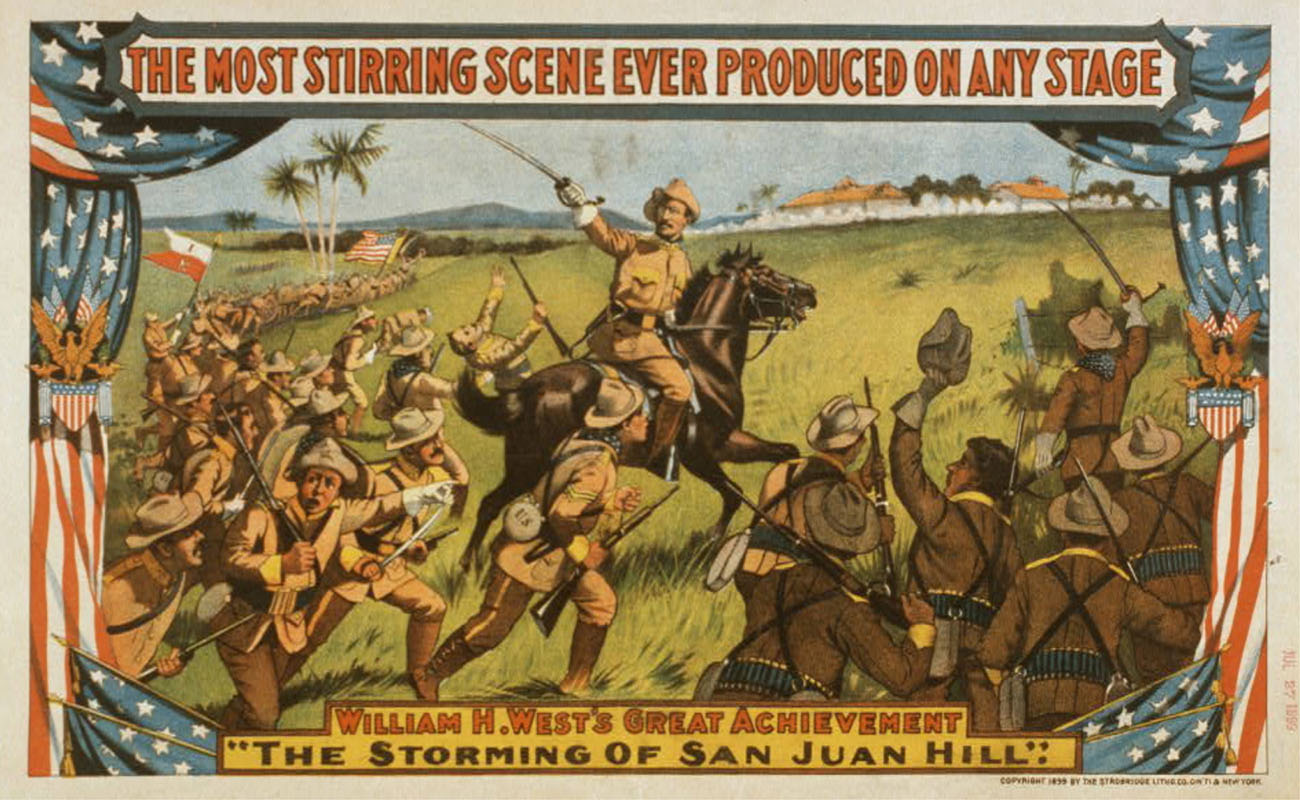Module 6: Age of Empire: American Foreign Policy, 1890-1914
Section outline
-
 Image from Chapter 22 in U.S. History (opens in new window) from OpenStax, licensed under Creative Commons Attribution License v4.0 with the image information: This poster advertises a minstrel show wherein an actor playing Theodore Roosevelt reenacts his leadership of the Rough Riders in the Spanish-American War and illustrates the American public’s zeal for tales of American expansionist glory.This module explores the Age of Empire, an era of American expansionism. In the last decades of the nineteenth century, after the Civil War, the United States pivoted from a profoundly isolationist approach to a distinct zeal for American expansion. American economic growth combined with the efforts of Evangelist missionaries to push for greater international influence and overseas presence. By confronting Spain over its imperial rule in Cuba, the United States took control of valuable territories in Central America and the Pacific. But at the same time, the country sought to expand its reach through another powerful tool: its economic clout. When Roosevelt succeeded McKinley as president, he implemented a key strategy for building an American empire: the threat, rather than the outright use, of military force. All around the globe, President Taft sought to use U.S. economic might as a lever in foreign policy. He relied less on military action, or the threat of such action, than McKinley or Roosevelt before him.Upon completion of this module, you will be able to:
Image from Chapter 22 in U.S. History (opens in new window) from OpenStax, licensed under Creative Commons Attribution License v4.0 with the image information: This poster advertises a minstrel show wherein an actor playing Theodore Roosevelt reenacts his leadership of the Rough Riders in the Spanish-American War and illustrates the American public’s zeal for tales of American expansionist glory.This module explores the Age of Empire, an era of American expansionism. In the last decades of the nineteenth century, after the Civil War, the United States pivoted from a profoundly isolationist approach to a distinct zeal for American expansion. American economic growth combined with the efforts of Evangelist missionaries to push for greater international influence and overseas presence. By confronting Spain over its imperial rule in Cuba, the United States took control of valuable territories in Central America and the Pacific. But at the same time, the country sought to expand its reach through another powerful tool: its economic clout. When Roosevelt succeeded McKinley as president, he implemented a key strategy for building an American empire: the threat, rather than the outright use, of military force. All around the globe, President Taft sought to use U.S. economic might as a lever in foreign policy. He relied less on military action, or the threat of such action, than McKinley or Roosevelt before him.Upon completion of this module, you will be able to:- Explain the evolution of American interest in foreign affairs from the end of the Civil War through the early 1890s (CO 1-7)
- Identify the contributions of Frederick Jackson Turner and Alfred Thayer Mahan to the conscious creation of an American empire (CO 1-5)
- Explain the origins and events of the Spanish-American War (CO 1-7)
- Analyze the different American opinions on empire at the conclusion of the Spanish-American War (CO 1-5)
- Describe how the Spanish-American War intersected with other American expansions to solidify the nation’s new position as an empire (CO 1-5)
- Explain how economic power helped to expand America’s empire in China (CO 1-5)
- Describe how the foreign partitioning of China in the last decade of the nineteenth century influenced American policy (CO 1-5)
- Explain the meaning of “big stick” foreign policy (CO 1-7)
- Describe Theodore Roosevelt’s use of the “big stick” to construct the Panama Canal (CO 1-7)
- Explain the role of the United States in ending the Russo-Japanese War (CO 1-5)
- Explain how William Howard Taft used American economic power to protect the nation’s interests in its new empire (CO 1-5)
To achieve these objectives:
- Read the Module 6 Introduction above.
- Read and view the materials in Module 6 (click below)
- View the Module 6 PowerPoint below.
- Complete Module 6 quizzes/assignments/discussion boards based on chapter/document reading.
Module Pressbooks Resources and Activities
You will find the following resources and activities in this module at the Pressbooks website. Click on the links below to access or complete each item.
Background Colour
Font Face
Font Kerning
Font Size
Image Visibility
Letter Spacing
Line Height
Link Highlight
Text Colour
